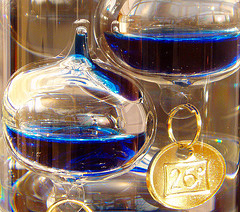Motivate...
Overview

When you're getting ready to start your day, do you ever wonder, "what's the high temperature going to be?" As a meteorologist, it's a question I get asked all the time (it's an occupational hazard, I suppose). Perhaps the only question I get more frequently is, "Do you think it's going to rain today / tomorrow?"
Most likely, your expectations for daily temperatures help you make decisions about what clothes to wear (whether to wear a coat or not, etc.), and you might be tempted to think that this important meteorological variable is easily determined by a few simple factors, but it isn't. Temperature is affected by many processes at several different time and space scales. Some of these factors are well understood and very predictable (like the seasons), while others present bigger challenges.
To complicate things, weather forecasters must be aware of other aspects of the forecast when they make a temperature prediction. For example, you've already learned that one of the factors for determining temperature on a local scale is the surface's energy budget, and clouds have a great influence on surface temperature during both the day and night. Therefore, in order to properly predict surface temperatures, a meteorologist must get the cloud prediction correct first. The same goes for wind direction and speed, which affects mixing from mechanical eddies and something called "temperature advection," which we'll learn about in this lesson. Temperature is also affected by precipitation, ground cover, urban versus rural landscapes, etc., and the list goes on. While the science of weather forecasting has advanced to the point where high and low temperature forecasts for the next few days are usually pretty accurate, sometimes predicting the temperature can be a real challenge, even for professionals.
In short, this lesson is all about controllers of temperature--from the global scale (such as seasons) to the local scale (such as temperature advection, clouds precipitation, ground cover, etc.), and everything in between. There's a lot to learn, so let's get started!